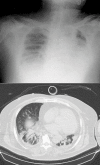H1N1 influenza-associated pneumonia with severe obesity: successful management with awake veno-venous extracorporeal membrane oxygenation and early respiratory physical therapy
- PMID: 29123779
- PMCID: PMC5667376
- DOI: 10.1002/ams2.165
H1N1 influenza-associated pneumonia with severe obesity: successful management with awake veno-venous extracorporeal membrane oxygenation and early respiratory physical therapy
Abstract
Case: We report a case of H1N1 influenza-associated respiratory failure with severe obesity.
Outcome: A 54-year-old man was admitted to our intensive care unit (ICU) because of H1N1 influenza-associated severe respiratory failure. He was severely obese, having a body mass index of 37.2. His respiratory condition remained severe under mechanical ventilation. We started veno-venous extracorporeal membrane oxygenation immediately. Awake management was started on ICU Day 6, and the patient's respiratory physical therapy began the following day. His respiratory condition showed excellent improvement immediately following the initiation of respiratory physical therapy. The patient was successfully decannulated on ICU Day 9, and he was discharged from the ICU on Day 11. He was discharged from the hospital with no severe disability on disease Day 60.
Conclusion: Awake extracorporeal membrane oxygenation management with early respiratory physical therapy can be useful in the treatment of morbidly obese patients who present with severe respiratory failure.
Keywords: Extracorporeal membrane oxygenation; H1N1 influenza; obesity; respiration; respiratory physical therapy.
Figures



Similar articles
-
Extracorporeal membrane oxygenation for 2009 influenza A (H1N1) acute respiratory distress syndrome: single-centre experience with 1-year follow-up.Eur J Cardiothorac Surg. 2012 Mar;41(3):691-5. doi: 10.1093/ejcts/ezr082. Epub 2012 Jan 6. Eur J Cardiothorac Surg. 2012. PMID: 22228837
-
[Recommendations of the Infectious Diseases Work Group (GTEI) of the Spanish Society of Intensive and Critical Care Medicine and Coronary Units (SEMICYUC) and the Infections in Critically Ill Patients Study Group (GEIPC) of the Spanish Society of Infectious Diseases and Clinical Microbiology (SEIMC) for the diagnosis and treatment of influenza A/H1N1 in seriously ill adults admitted to the Intensive Care Unit].Med Intensiva. 2012 Mar;36(2):103-37. doi: 10.1016/j.medin.2011.11.020. Epub 2012 Jan 13. Med Intensiva. 2012. PMID: 22245450 Spanish.
-
Extracorporeal membrane oxygenation for pandemic H1N1 2009 respiratory failure.Minerva Anestesiol. 2010 Dec;76(12):1043-51. Minerva Anestesiol. 2010. PMID: 21178913
-
Extracorporeal membrane oxygenation for avian influenza A (H7N9) patient with acute respiratory distress syndrome: a case report and short literature review.BMC Pulm Med. 2017 Feb 14;17(1):38. doi: 10.1186/s12890-017-0381-y. BMC Pulm Med. 2017. PMID: 28196469 Free PMC article. Review.
-
Spontaneous breathing during veno-venous extracorporeal membrane oxygenation.J Thorac Dis. 2018 Mar;10(Suppl 5):S661-S669. doi: 10.21037/jtd.2017.10.27. J Thorac Dis. 2018. PMID: 29732184 Free PMC article. Review.
Cited by
-
Modalities of Exercise Training in Patients with Extracorporeal Membrane Oxygenation Support.J Cardiovasc Dev Dis. 2022 Jan 20;9(2):34. doi: 10.3390/jcdd9020034. J Cardiovasc Dev Dis. 2022. PMID: 35200688 Free PMC article. Review.
-
Safety and potential benefits of physical therapy in adult patients on extracorporeal membrane oxygenation support: a systematic review.Rev Bras Ter Intensiva. 2019 May 13;31(2):227-239. doi: 10.5935/0103-507X.20190017. Rev Bras Ter Intensiva. 2019. PMID: 31090853 Free PMC article.
-
Veno-venous extracorporeal membrane oxygenation in the management of refractory bilateral bronchial dehiscence after lung transplant: a case report.JA Clin Rep. 2021 Oct 16;7(1):77. doi: 10.1186/s40981-021-00480-6. JA Clin Rep. 2021. PMID: 34654984 Free PMC article.
References
-
- Peek GJ, Mugford M, Tiruvoipati R et al Efficacy and economic assessment of conventional ventilatory support versus extracorporeal membrane oxygenation for severe adult respiratory failure (CESAR): A multicenter randomized controlled trial. Lancet 2009; 374: 1351–1363. - PubMed
-
- Vaughan RW, Bauer S, Wise L. Effect of position (semirecumbent versus supine) on postoperative oxygenation in markedly obese subjects. Anesth. Analg. 1976; 55: 37–41. - PubMed
-
- Weig T, Janitza S, Zoller M et al Influence of abdominal obesity on multiorgan dysfunction and mortality in acute respiratory distress syndrome patients treated with prone positioning. J. Crit. Care 2014; 29: 557–561. - PubMed
Publication types
LinkOut - more resources
Full Text Sources
Other Literature Sources

